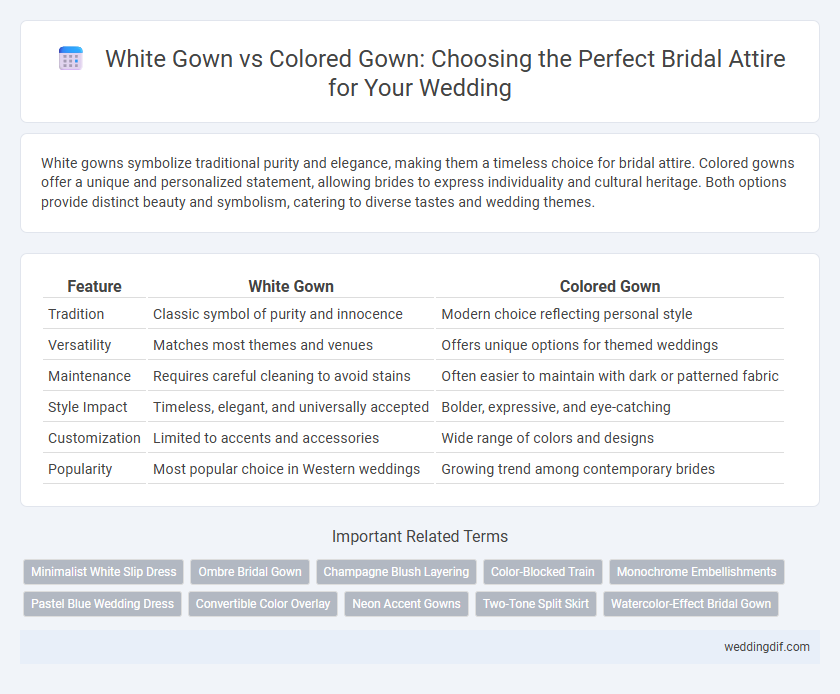White gowns symbolize traditional purity and elegance, making them a timeless choice for bridal attire. Colored gowns offer a unique and personalized statement, allowing brides to express individuality and cultural heritage. Both options provide distinct beauty and symbolism, catering to diverse tastes and wedding themes.
Table of Comparison
| Feature | White Gown | Colored Gown |
|---|---|---|
| Tradition | Classic symbol of purity and innocence | Modern choice reflecting personal style |
| Versatility | Matches most themes and venues | Offers unique options for themed weddings |
| Maintenance | Requires careful cleaning to avoid stains | Often easier to maintain with dark or patterned fabric |
| Style Impact | Timeless, elegant, and universally accepted | Bolder, expressive, and eye-catching |
| Customization | Limited to accents and accessories | Wide range of colors and designs |
| Popularity | Most popular choice in Western weddings | Growing trend among contemporary brides |
Introduction: The Bridal Gown Dilemma
Choosing between a white gown and a colored gown for bridal attire involves balancing tradition with personal expression, as white symbolizes purity and classic elegance while colored gowns offer vibrant individualism and cultural significance. White bridal gowns dominate Western weddings, often crafted from fabrics like satin, lace, and tulle that enhance the timeless aesthetic. Colored gowns--ranging from blush pink to deep burgundy--reflect diverse cultural practices and modern trends, allowing brides to make a bold style statement on their wedding day.
Historical Significance of the White Wedding Gown
The white wedding gown gained widespread popularity in the 19th century, largely due to Queen Victoria's 1840 wedding dress choice, symbolizing purity and social status. Traditionally, white gowns represent innocence and new beginnings, influencing bridal fashion trends across Western cultures. In contrast, colored gowns often reflect cultural heritage or personal expression, but the white gown remains the iconic symbol of Western bridal attire.
The Rise of Colored Gowns in Modern Weddings
Colored gowns in modern weddings have gained significant popularity, offering brides a bold alternative to traditional white attire. Shades like blush, lavender, and even deep jewel tones are favored for their ability to express individuality and cultural heritage. This trend reflects a shift towards personalized bridal fashion, emphasizing unique style over conventional norms.
Symbolism: What Do White and Colored Gowns Represent?
White bridal gowns traditionally symbolize purity, innocence, and new beginnings, reflecting cultural norms rooted in Western wedding customs. Colored gowns, ranging from vibrant reds to pastel blues, often represent individuality, cultural heritage, and personal expression, with specific hues carrying unique meanings, such as red for prosperity in Chinese weddings or blue for fidelity in some Western traditions. Choosing between white and colored gowns allows brides to convey distinct symbolic messages aligned with their values, cultural backgrounds, and personal style.
Fashion Trends: White vs Colored Bridal Gowns
White bridal gowns remain a timeless classic symbolizing purity and tradition, dominating most wedding fashion trends worldwide. Colored gowns, ranging from soft pastels to bold jewel tones, are gaining popularity for brides seeking to express individuality and modern style. Fashion designers increasingly incorporate unique hues and embellishments, blending traditional elegance with contemporary flair to cater to diverse bridal preferences.
Cultural Influences on Bridal Gown Choices
Cultural influences heavily shape bridal gown choices, with white gowns symbolizing purity and tradition in Western cultures, while colored gowns are preferred in many Asian and African weddings to represent prosperity and joy. In Indian weddings, vibrant reds and golds dominate, reflecting cultural heritage and auspiciousness, whereas in Western countries, the classic white gown remains a symbol of modern bridal fashion. These cultural preferences highlight the diversity and significance of bridal attire across different societies.
Personal Expression: Choosing the Perfect Hue
Selecting a white gown for bridal attire symbolizes tradition, purity, and timeless elegance, while colored gowns offer a bold avenue for personal expression, reflecting individuality and cultural influences. Brides opting for shades like blush, lavender, or deep jewel tones embrace uniqueness and modernity, making their wedding attire a statement of personality rather than convention. The decision between white and colored gowns ultimately centers on aligning the hue with the bride's identity, style preferences, and the overall theme of the wedding celebration.
Practical Considerations: Stain Risk and Maintenance
White gowns for bridal attire often demand meticulous care due to their high visibility of stains and susceptibility to discoloration, requiring professional cleaning and careful handling throughout the event. Colored gowns offer a practical advantage by better concealing stains from food, drinks, or outdoor elements, reducing immediate maintenance concerns. Choosing a colored gown can therefore enhance comfort and confidence during the wedding day, minimizing stress over accidental spills and prolonged upkeep.
Celebrity Inspirations: Iconic White and Colored Bridal Looks
Celebrity inspirations for bridal attire showcase iconic white gowns like Kate Middleton's Alexander McQueen dress, embodying timeless elegance and tradition, contrasted with bold colored gowns such as Priyanka Chopra's red Ralph Lauren ensemble, which symbolize cultural richness and individuality. White gowns continue to dominate royal and classic weddings, while celebrities like Billie Eilish and Solange Knowles push boundaries with vibrant, unconventional hues that captivate fashion trends. These iconic looks influence bridal attire choices, merging heritage with modern expression through both white and colored gowns.
Making the Final Choice: Tips for Brides-to-Be
Brides-to-be should consider personal style, wedding theme, and cultural significance when choosing between a white gown and a colored gown. White gowns symbolize tradition and purity, fitting classic or formal weddings, while colored gowns offer bold expression and uniqueness, ideal for destination or themed ceremonies. Prioritizing comfort, silhouette, and fabric alongside color choice ensures the bride feels confident and radiant on her special day.
White Gown vs Colored Gown for Bridal Attire Infographic

 weddingdif.com
weddingdif.com